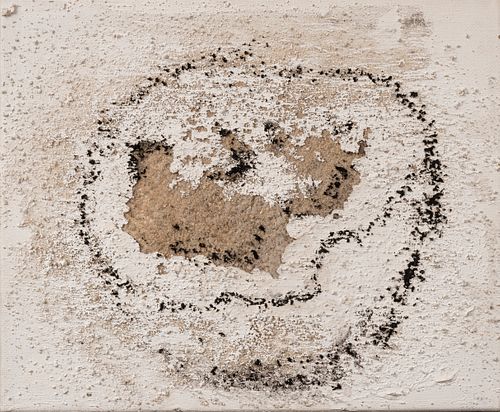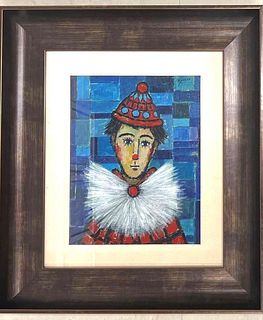MIQUEL BARCELÓ ARTIGUES (Felanitx, Mallorca, 1957). "1/2", 2005. Mixed technique on canvas. Attached certificate issued by the Bruno Bischofberger AG
Lot 80
About Seller
Setdart Auction House
Carrer Aragó 346
Barcelona
Spain
Setdart Subastas was born in 2004 and is currently the first online art auction in Spain with solidity, prestige and reliability guaranteed by our more than 60,000 users. Setdart has a young, dynamic and enterprising team ready to successfully manage the purchase and sale of art works through custom...Read more
Categories
Estimate:
$45,000 - $50,000
Absentee vs Live bid
Two ways to bid:
- Leave a max absentee bid and the platform will bid on your behalf up to your maximum bid during the live auction.
- Bid live during the auction and your bids will be submitted real-time to the auctioneer.
Bid Increments
| Price | Bid Increment |
|---|---|
| $0 | $10 |
| $200 | $25 |
| $500 | $50 |
| $1,000 | $100 |
| $3,000 | $200 |
| $5,000 | $500 |
| $10,000 | $1,000 |
| $20,000 | $2,000 |
| $50,000 | $5,000 |
About Auction
By Setdart Auction House
Jun 17, 2021
Set Reminder
2021-06-17 06:15:00
2021-06-17 06:15:00
America/New_York
Bidsquare
Bidsquare : 19th & 20th Century Contemporary Art - Select Lots
https://www.bidsquare.com/auctions/setdart-auction-house/19th-20th-century-contemporary-art---select-lots-7081
Setdart Auction House sofia@setdart.com
Setdart Auction House sofia@setdart.com
- Lot Description
MIQUEL BARCELÓ ARTIGUES (Felanitx, Mallorca, 1957). "1/2", 2005. Mixed technique on canvas. Attached certificate issued by the Bruno Bischofberger AG Gallery (Zurich). Signed, dated and titled on the back. Measures: 38.5 x 46 cm; 76 x 84 cm (frame). This work by Barceló presents itself to the viewer as an independent territory that invites exploration and investigation. Its surface is irregular, full of nuances, determined by a mass of matter that, in certain areas, vanishes, thus reflecting organic life in movement, a struggle to free itself, to show what it hides beneath its surface. It is a work that can be apprehended as a landscape that describes a kind of marternal womb, both for its texture and its format, but that goes beyond that, revealing to us a kind of telluric philosophy. This work is also clearly influenced by Antoni Tàpies, since the Mallorcan artist shares with him a fascination for texture and surface, and creates a work that is tantalizingly tactile, rough, and gritty. Barceló also shows himself to be close to another of the masters who influenced him, Dubuffet, in order to create a work that not only tries to represent the landscape, but also incorporates it, physically recreates it. The work is accompanied by a certificate issued by the Bruno Bischofberger Gallery, with which Barceló began to work exclusively since 1984. Only a year after meeting Bruno Bischofberger in Naples. A painter and sculptor, Barceló began his training at the School of Arts and Crafts in Palma de Mallorca, where he studied between 1972 and 1973. In 1974 he made his individual debut, at the age of seventeen, at the Picarol Gallery in Mallorca. That same year he moved to Barcelona, where he enrolled at the Sant Jordi School of Fine Arts, and made his first trip to Paris. In the French capital he discovers the work of Paul Klee, Fautrier, Wols and Dubuffet, as well as the "art brut", a style that will exert an important influence on his first paintings. During these years he reads extensively, and enriches himself with works as diverse as the writings of Breton and the surrealists, the "White Manifesto" by Lucio Fontana or the "Social History of Literature and Art" by Arnold Hauser. In 1976 he held his first solo exhibition in a museum: "Cadaverina 15" at the Museum of Mallorca, consisting of a montage of 225 wooden boxes with glass lids, with decomposing organic materials inside. That same year, back in Mallorca, he joined the Taller Lunàtic group and took part in its social, political and cultural events. In 1977 he makes a second trip to Paris, and also visits London and Amsterdam. That same year he exhibits for the first time in Barcelona, and meets Javier Mariscal, who will become one of his best friends in the city. Together with him and the photographer Antoni Catany he participates, as a member of the group "Neón de Suro", in exhibitions in Canada and California, and collaborates with the publication of the magazine of the same name. It was also in 1977 when he received his first large-format pictorial commission: a mural for the dining room of a hotel in Cala Millor, Mallorca. The following year, at the age of twenty-one, he sells his first works to some collectors and galleries, and finally moves to Barcelona. His international recognition began in the early eighties, giving a definitive boost to his career after his participation in the São Paulo Biennial (1981) and the Documenta in Kassel (1982). In 1986 he was awarded the National Prize of Plastic Arts, and since then his work has received numerous awards, such as the Prince of Asturias Award for the Arts (2003) or the Sorolla Prize of the Hispanic Society of America in New York (2007). Barceló is currently represented in the most important art museums in the world, such as the MoMA in New York, the Centre Pompidou in Paris, the Guggenheim in Bilbao, etc.
- Shipping Info
-
In-house shipping available. Please inquire at admin@setdart.com.
-
- Buyer's Premium



 EUR
EUR CAD
CAD AUD
AUD GBP
GBP MXN
MXN HKD
HKD CNY
CNY MYR
MYR SEK
SEK SGD
SGD CHF
CHF THB
THB

















